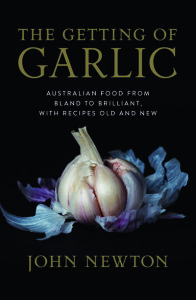Book Review: “The Getting of Garlic” by John Newton
by Jan

This book is very readable. It looks at the emergence of a national cuisine, and examines traditions and definitions until we arrive at a ‘Mongrel’ cuisine.
My mother was a traditional meat and three veg cook. She knew how to make decent gravy without the adulteration of the commercial packet variety. However, she did not enjoy baking; it was a chore and endured out of obligation if visitors were looming on the horizon.
Unlike the colonial cohort mentioned in this book, she was not frightened or repulsed by garlic. Up to the influx of immigrants post WWII, garlic was largely considered unseemly ‘wog food’. Before garlic (BG).
I was peeling vegetables and stirring the gravy at primary school age. Later I was monopolizing the kitchen in shared flats; the guinea pigs did not complain.
As I appeared to be so keen on cooking a flat mate suggested I enrol in a Cordon Bleu course. Bedtime reading was Elizabeth David and Claudia Roden et al. By this time, it was the Post Garlic (PG) era. I had developed what Newton describes as Essengeist, or eating spirit.
The chapter titled “The Multiculinary Society Emerges” is about traffic going the other way: people travelling the other way, mostly backpackers towards UK and Europe.
But before I left the Antipodes, I was already in love with garlic prawns, which at the time was the quintessential garlic dish. Goodbye blandness – the era was now PG (Post Garlic).
Working as a cook, I read the restaurant critiques, just to see what restaurants were being disparaged and why, and what were worth considering, income permitting. The reviewers, I felt, had too much influence; it seemed they had the power to force the closure of some perfectly reasonable restaurants. Unfairly, the restaurateurs had no right of reply, but most of them were the ones who knew how to cook, not the reviewers!
In the 19th century the dominant cuisine was French, but it wasn’t until the 1980s when the cult of the celebrity chef appeared, that Mod Oz was influential. It was basically French techniques, with simpler and more natural presentation.
Our celebrity chefs were heavily influenced by French celebrity chefs. Although none was using Australian indigenous foods, there was a lot of borrowing, or bricolage.
The food writers and restaurant critics (mostly male) over-estimated their influence. They could have been encouraging the use of indigenous foods but they failed.
The food writers and reviewers could not influence the leap to television food, then social media. But later in the 2000s the TV celebrity chef became dominant, their shows being accompanied by their cookbooks.
A lot has been written about the Masterchef effect; as Newton states it’s a fan-based food culture. So what constitutes a real cuisine?
Apparently, the appearance of a tradition including an abundance of ingredients, and a set of attitudes about foods. Also a critical mass of enthusiastic eaters with a willingness to try unfamiliar food.
Australia qualifies with these criteria, but the problem is that they were imported from UK over 200 years ago. Newton states “To be Australian is to be multi-cultural, multi-culinary – a mongrel”.
But until recently we were stuck in a rut, usually due to fear of the unknown, mutual mistrust from both Anglos and Indigenous peoples.
It seemed very strange that a foreign chef, Rene Redzepi, had to tell an Australia audience that native foods were all around us, but had been ignored for far too long!
Back to garlic – here’s Newton’s final sentence, quoting Boulestin in Elizabeth David’s A Book of Mediterranean Food: “It is not really an exaggeration to say that peace and happiness begin, geographically, where garlic is used in cooking.” Amen to that.